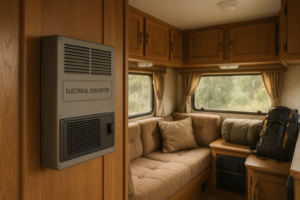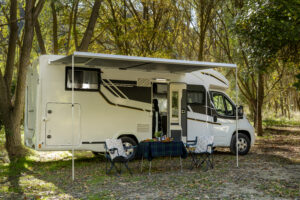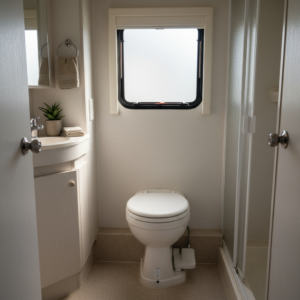
How to Winterize an RV: A Step-by-Step Guide to Protect Your Home-on-Wheels
Table of Contents
If you’ve spent all year making memories in your RV, the last thing you want is to return to it after winter and find cracked pipes, mildew, or worse. Winter can be brutal on an RV if it’s not prepped correctly. Pipes freeze. Seals crack. Moisture sneaks in. And suddenly, what should be your cozy escape feels more like a renovation project.
Winterizing your RV is about more than just pouring in some antifreeze and calling it a day. It’s about protecting your investment and keeping your rig road-ready for spring and ensuring you don’t face avoidable repairs. Whether you’re planning to store it until warmer weather or you’re gearing up for a chilly adventure, this guide will walk you through the winterization process to get your RV prepped for the cold the right way.
Why Bother Winterizing Your RV?
Think winterizing sounds like overkill? It’s not. In fact, it’s the smartest thing you can do before the temperatures drop. And winterizing isn’t just for people who live in snowy states. Even in milder climates, a surprise cold snap can wreak havoc on your RV’s plumbing and systems. Water left in your RV can freeze and expand, wreaking havoc on pipes and tanks. Seals and exteriors take a beating from harsh weather, and even your interior isn’t safe from mold and critters.
Skipping winterization might save time now, but you’ll pay for it later, often literally. Here’s why winterizing is worth your time:
- Frozen pipes are a real threat: Water expands when it freezes. That expansion can crack your water lines, fittings, and even your water heater tank. Once that happens, you’re looking at costly repairs and a lot of hassle.
- Mold & mildew don’t take a break: If moisture gets trapped inside your RV, especially in the kitchen or bathroom areas, you’re inviting mold and mildew to settle in. They’re not only hard to remove—they’re health hazards too.
- Appliances aren’t immune: From your water heater to your pumps and tanks, freezing temps can put stress on systems that weren’t designed to handle ice. Winterizing helps shield these parts from the cold.
- Exterior damage can sneak up on you: Snow, ice, and UV rays are a triple threat to your RV’s exterior. Tires crack, seals dry out, and roofs take a beating if left unprotected.
- Insurance might not help: Many RV insurance policies don’t cover freeze-related damage if the RV wasn’t winterized properly. That means one missed step could turn into a denied claim.
What You’ll Need Before You Start
Here’s a quick checklist of tools and supplies to gather before you get started:
- RV-specific antifreeze (non-toxic, pink-colored, made for potable water systems)
- Air compressor and blow-out plug (30–50 PSI max)
- Water heater bypass kit (many modern RVs already have one installed)
- Basic tools: socket wrench, flathead screwdriver, pliers
- Lubricants: WD-40 or similar, for locks and hinges
- RV covers (especially for tires and roof)
- Vent caps
- Window insulation such as Reflectix
- Moisture absorbers or dehumidifiers
- Rodent deterrents: dryer sheets, peppermint oil, or commercial repellents
Optional but helpful: Masking tape for labeling faucets or systems, a flashlight or headlamp, and gloves (especially if it’s already cold out).
Step-by-Step: How to Winterize Your RV
Now that you’re prepped and ready, it’s time to get hands-on. Whether you’re a seasoned RVer or winterizing for the first time, following these steps in order will help ensure nothing gets missed.
1. Drain All Water Systems
Start with the basics—get every drop of water out of your system.
- Empty the fresh water tank
- Dump the gray and black water tanks at a designated dump station. Use a tank wand or flush system to clean out any lingering debris. This helps avoid nasty odors or bacteria growth while your RV is in storage.
- Open all faucets, showers, and low-point drains. Let gravity do its work.
- Don’t forget outdoor showers, ice makers, and washer/dryer hookups if you have them.
2. Blow Out the Water Lines (Optional But Recommended)
Using compressed air is a great way to push out any leftover moisture in your lines.
- Set your compressor to 30–50 PSI max.
- Attach a blow-out plug to the city water connection.
- Open one faucet at a time, starting with the one closest to the connection, and move farther away.
- Bypass the water heater if you haven’t already. Note that on-demand water heaters should not be bypassed and should be filled with antifreeze along with the rest of the plumbing system.
- It’s also wise to turn off the 120VAC breaker for tank-style water heaters to avoid damaging the heating element if the unit is accidentally powered on.
This step is especially useful if you’re storing in areas with deep freezes. It’s not a substitute for antifreeze, but it makes the process more thorough.
3. Add RV Antifreeze
Now, for one of the most important steps – running antifreeze through your system.
- Use a pump conversion kit or siphon antifreeze through the RV’s water pump.
- Open each faucet (both hot and cold) until you see pink antifreeze flowing.
- Flush the toilet and run outdoor showers, low-point drains, and any interior water features.
- Appliances like ice makers, refrigerators with water dispensers, washing machines, and dishwashers should also be run through a short cycle using RV antifreeze to ensure all water lines are protected.
- Pour antifreeze into sink and shower drains, as well as P-traps. This keeps them from freezing and cracking.
Make sure your city water inlet and water filter canisters are also drained and filled, or bypassed.
Not sure if you’ve covered every system or need help prepping hard-to-reach components? Good Sam RV ProCare’s RV maintenance services offer winterization support and preventive system checks to help you avoid costly freeze damage.
4. Clean and Prep the Interior
Winter is when rodents and pests start looking for cozy places. Don’t let your RV become one.
- Remove all food, dry goods, and anything that could attract critters.
- Wipe down countertops and floors with a disinfectant.
- Empty the fridge and freezer. Leave doors cracked to prevent mold.
- Set out moisture absorbers or a small dehumidifier, especially in humid areas.
- Close all blinds or use materials such as Reflectix to insulate windows.
5. Protect the Exterior
This is often overlooked, but is just as important.
- Seal any cracks or worn weatherstripping around windows and doors.
- Use permanent or temporary vent and air conditioning covers to keep snow and bugs out.
- Add RV skirting or an inflatable skirt system to insulate the undercarriage.
- Cover tires with UV-resistant covers.
- If storing outside, consider a breathable RV cover that won’t trap moisture.
- Clean and inspect the roof for damage or soft spots. Re-seal if needed.
6. Take Care of Your Engine & Batteries
If you’ve got a motorhome, don’t skip this step:
- Add a fuel stabilizer to the fuel tank. Run the engine for a few minutes to circulate it.
- Check and top off all fluids – oil, coolant, brake fluid.
- Disconnect the battery and store it in a cool, dry place. Use a trickle charger if possible.
- If your RV has house batteries, disconnect and store them appropriately too.
7. Pick a Smart Storage Location
Where you store your RV plays a big role in how well it weathers the winter.
- Indoor storage offers protection from snow, ice, and UV damage. It’s ideal, but not always accessible.
- Outdoor storage works fine if you use the right covers and prep steps. Just be sure to check on your RV periodically through the season.
- No matter where you store it, make sure it’s level and that the tires are properly inflated. You can also use leveling blocks or jacks to take the pressure off the tires.
Need help choosing or preparing a spot? RV ProCare’s location finder can help you find winterization and storage services nearby.
Pro Tips & Common Pitfalls to Avoid
There are a few things experienced RVers learn the hard way. Here’s how to avoid them:
Do:
- Use masking tape to label which systems have been winterized. It’ll save you time in spring.
- Winterize before your region’s first expected freeze, not after.
- Check your RV manual for any model-specific steps.
Don’t:
- Use automotive antifreeze. It’s toxic and not safe for your plumbing system.
- Forget lesser-known spots such as exterior showers, ice makers, or dishwasher hookups.
- Leave food or dry goods in the pantry. Even sealed items can attract mice.
When to Call in the Pros
Some RVs are simple to winterize. Others? Not so much.
If your rig has a complex plumbing setup, built-in filtration systems, or you’re just short on time, it’s totally okay to hand it off to an expert.
Here are a few scenarios where professional help is not just helpful, but highly recommended:
- You have a complex plumbing system: Fifth wheels, Class A motorhomes, or luxury RVs often come with intricate plumbing, multiple bathrooms, and hidden water lines. Missing just one low-point drain or bypass valve could lead to major freeze damage. Pros know exactly where to look and what to check.
- You use onboard water filtration or water softeners: These components need to be bypassed or winterized separately. If handled incorrectly, they can crack or lose function entirely. A technician can make sure every system is properly treated and protected.
- Your RV has residential appliances: Fridges with ice makers, dishwashers, washers/dryers, or even built-in espresso machines (yes, it’s a thing!) require extra steps to flush water lines or apply antifreeze correctly. These systems are expensive to replace and deserve expert attention.
- You’re storing in extreme climates: If you’re parking in areas where winter temps regularly drop below zero, every step of winterization becomes more critical. Pros can take extra precautions, such as additional insulation or heated tank prep, to keep your rig safe through deep freezes.
- You’ve never winterized before: If this is your first time, there’s no shame in letting someone else show you the ropes. Watching a professional service once can give you confidence to DIY it next time, without risking costly rookie mistakes.
- You’re short on time or tools: If you don’t have access to an air compressor, antifreeze pump, or even a level storage pad, a mobile winterization service can come to you. They bring the tools, know-how, and checklists so nothing is overlooked.
- You want a complete systems check before storage: Winterizing is the perfect opportunity to get a head-to-toe health check on your RV – checking batteries, brakes, roof seals, fluid levels, and more. Think of it as a seasonal physical for your home on wheels.
The team at Good Sam RV ProCare can walk you through the process or do it for you, saving you the guesswork.
Whether it’s a simple antifreeze job or a full systems check, they’ve got the tools and know-how to get it done right.
Where We Work: Service Areas
Good Sam RV ProCare provides expert winterization services across multiple U.S. states—so whether you’re staying local or traveling south for the season, there’s likely a RV ProCare team near you.
To find your nearest location and explore available services, check out our service areas:
Final Thoughts
Winterizing your RV might not be the most glamorous part of RV life, but it’s an extremely important one. A few hours of prep now can save you weeks (and thousands of dollars) come spring.
Whether you’re doing it all yourself or getting a hand from the pros, taking the time to prepare your RV for winter will keep your adventures rolling smoothly when the weather warms up again.
Stay warm, stay safe – and here’s to hitting the road again soon!


